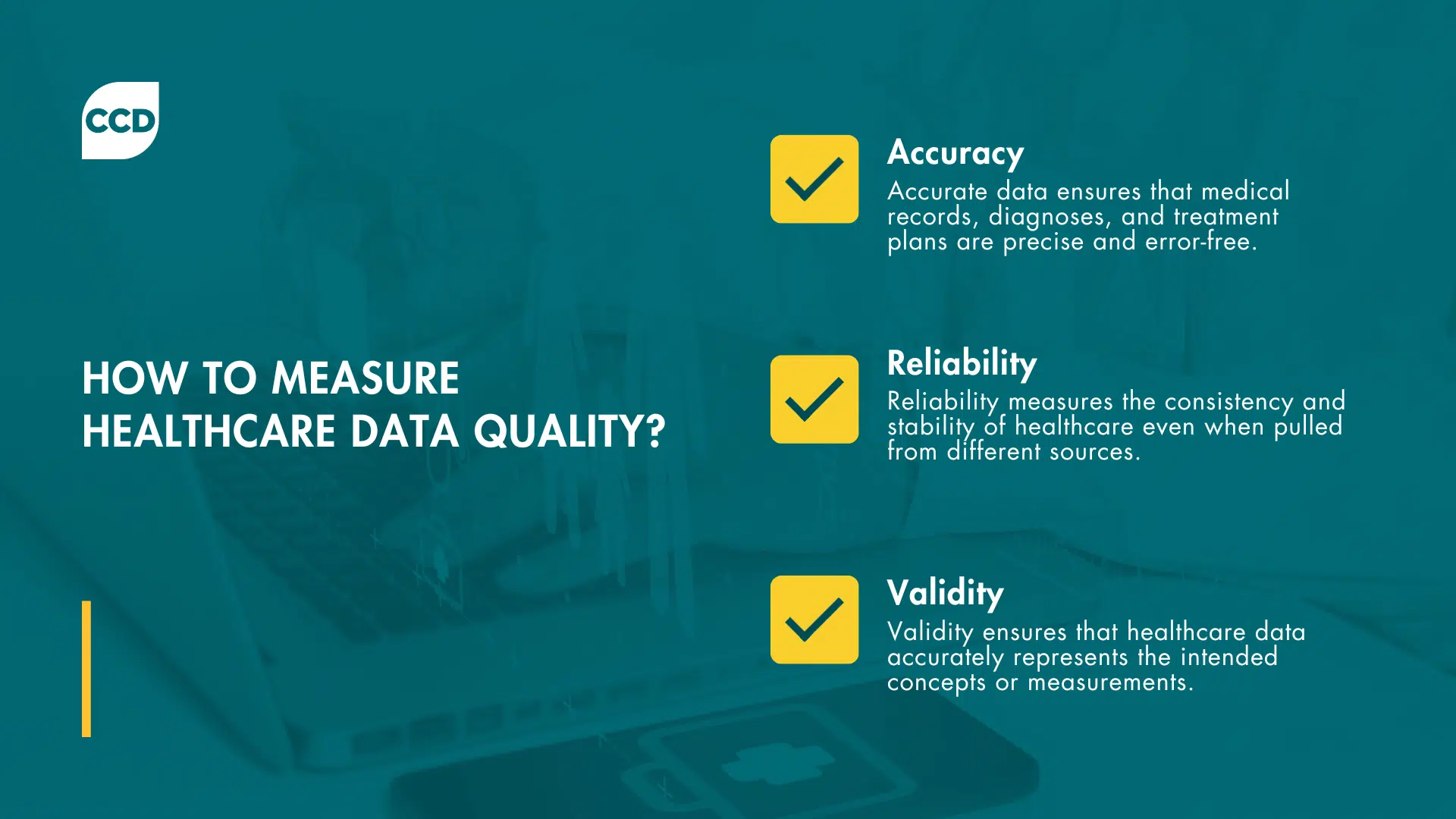How Healthcare Data Quality Impacts Patient Outcomes

Discover the importance of data quality in healthcare, how it affects patient outcomes, and how it can be improved.
Healthcare data quality refers to the accuracy, completeness, and reliability of information stored in electronic health records (EHRs), databases, and other health information systems. It encompasses a spectrum of factors, including data integrity, consistency, and timeliness.
Healthcare professionals rely heavily on accurate and timely data to make informed patient care and operations management decisions.
In fact, 88.2% of office-based physicians use EMR/EHR systems to store patient data. (source)
As such, inaccuracies or omissions in this data can lead to misdiagnoses, loss of revenue, incorrect treatments, and compromised patient safety.
Precise healthcare data, then, have become essential to map effective treatment plans and foster transparent communication between healthcare providers and patients. When patients have access to accurate information about their health, they are better equipped to actively participate in their care, leading to improved adherence to treatment plans and healthier outcomes.
How do we measure healthcare data quality?
Accuracy
In healthcare, accurate data ensures that medical records, diagnoses, and treatment plans are precise and error-free.
Methods for Assessing Accuracy
- Cross-Verification: Compare data across multiple sources to identify inconsistencies.
- Chart Audits: Conduct periodic audits of patient charts to ensure alignment with electronic health records.
- Data Entry Validation: Implement validation rules during data entry to catch real-time errors.
Reliability
Reliability measures the consistency and stability of healthcare data over time. Reliable data is dependable and can be trusted for decision-making. Inconsistent and unreliable data can lead to misunderstanding, misdiagnoses, and suboptimal patient care.
Strategies to Evaluate Reliability
- Temporal Stability: assess data consistency over different periods.
- Inter-Rater Reliability: evaluate the agreement among individuals entering or interpreting data.
- Test-Retest Reliability: measure data consistency by repeating the same assessments over a specified time interval.
Validity
Validity ensures that healthcare data accurately represents the intended concepts or measurements. Valid data is essential for drawing meaningful conclusions and avoiding misinterpretations that significantly affect patient care.
Methods to assess validity
- Content Validity: Evaluate the relevance and comprehensiveness of data about the intended concept.
- Construct Validity: Assess the degree to which data accurately measures the theoretical construct it intends to represent.
- Criterion-Related Validity: Compare data against a gold standard or established criteria to determine accuracy.
The effect of poor data quality on patient outcomes
1. Misdiagnosis and delayed treatment
Accurate and timely diagnoses are fundamental to successful patient outcomes. Poor data quality introduces a significant risk of misdiagnoses, leading to delayed or inappropriate treatment plans. Inaccurate patient information misinterpreted test results, or incomplete medical histories can contribute to healthcare providers making suboptimal decisions. The consequences of misdiagnoses extend beyond the immediate, potentially resulting in prolonged suffering, increased healthcare costs, and diminished overall patient well-being.
2. Medication errors
Effective medication management depends on precise and up-to-date patient information. Poor data quality can lead to errors in medication administration, dosage miscalculations, or inappropriate prescriptions. These errors threaten patient safety, causing adverse reactions, treatment inefficacies, or life-threatening situations. Addressing the root cause of poor data quality is essential to mitigate the risks associated with medication errors and uphold patient care integrity.
3. Patient management
Comprehensive patient management relies heavily on accurate and comprehensive data. Incomplete or inconsistent patient records hinder healthcare professionals’ ability to develop personalized treatment plans, monitor progress, and coordinate care effectively. Poor data quality can result in fragmented patient histories, hindering the seamless exchange of information among healthcare providers. Enhanced data quality is paramount for fostering collaboration, ensuring continuity of care, and optimizing patient outcomes.
4. Missed Revenue
Beyond its direct impact on patient health, poor data quality also has financial implications for healthcare organizations. Inaccuracies in patient billing information, coding errors, and incomplete documentation can lead to missed revenue opportunities. Addressing data quality issues is a matter of improving patient outcomes and a strategic initiative to optimize revenue cycles and financial sustainability for healthcare providers.
How can Healthcare Centers overcome Data Quality issues?
-
Implement data governance frameworks
Implementing comprehensive frameworks ensures healthcare organizations have policies and procedures to maintain data quality. This includes standardized data entry protocols, regular audits, and continuous staff training.
2. Invest in training
One of the primary ways healthcare centers can combat data quality issues is through comprehensive training programs for their staff. Ensuring that personnel are well-versed in data entry protocols, understand the importance of accurate documentation, and are familiar with the potential consequences of data errors.
Key training initiatives
- Data Entry Protocols: Provide detailed guidelines on accurately inputting patient information into electronic health records (EHRs) or other data systems.
- Continuous Education: Establish ongoing training sessions to update staff on new data entry protocols, technologies, and best practices.
- Awareness Campaigns: Foster a culture of data quality by raising awareness about the impact of accurate data on patient outcomes.
3. Standardize data
Healthcare centers often use many data sources, including departments, systems, and external partners. Data standardization involves establishing uniform data formats, definitions, and coding systems to ensure consistency across the organization.
Steps for data standardization
- Define Data Elements: Clearly outline the essential data elements required for patient records and healthcare processes.
- Adopt Industry Standards: Embrace widely accepted coding systems and standards to enhance interoperability and streamline data exchange.
- Regularly Update Protocols: Stay proactive by updating data standardization protocols to align with industry advancements and changing organizational needs.
4. Perform regular audits and monitoring
Regular audits and monitoring processes are pivotal in promptly identifying and rectifying data quality issues. Healthcare centers can proactively detect inconsistencies, errors, and potential risks by implementing robust audit programs.
Audit and monitoring best practices
- Routine Data Audits: Conduct regular patient records and other critical data audits to identify inaccuracies and discrepancies.
- Real-Time Monitoring: Implement tools and technologies that enable real-time monitoring of data inputs, allowing for immediate correction of errors.
- Establish Data Quality Metrics: Define key performance indicators (KPIs) related to data quality and regularly assess and report on these metrics.
What technologies can help improve data quality in the Healthcare industry?
These technologies not only have the capacity to streamline processes and reduce errors but also hold the promise of ushering in a new era of data-driven healthcare.
Machine learning
In the healthcare sector, ML algorithms can be harnessed to enhance data quality in various ways.
Applications of Machine Learning in data quality:
- Predictive Analytics: ML algorithms can predict potential anomalies or errors by analyzing patterns and historical data, enabling proactive correction.
- Natural Language Processing (NLP): NLP technology can improve the accuracy of clinical documentation by understanding and interpreting unstructured data, such as physician notes and patient narratives.
- Anomaly Detection: ML models can identify unusual patterns or outliers in data, signaling potential errors or inaccuracies that may require further investigation.
Artificial intelligence
From automating repetitive tasks to improving decision-making processes, AI can be a game-changer.
AI is used for data quality improvement.
Automated data cleansing: AI-powered tools can automatically identify and rectify inconsistencies, duplications, and errors in large datasets, ensuring data accuracy.
- Decision support systems: AI-driven decision support systems can assist healthcare professionals in making informed decisions by analyzing vast amounts of data quickly and accurately.
- Cognitive computing: AI systems with cognitive capabilities can understand, reason, and learn from complex healthcare data, contributing to more accurate and personalized patient care.
Final thoughts
From accurate diagnoses to effective treatment plans, every aspect of patient care relies on the integrity of healthcare data. As technology advances, embracing innovative solutions and robust data governance frameworks becomes imperative to ensure a future where healthcare data quality is synonymous with improved patient well-being.




